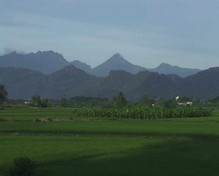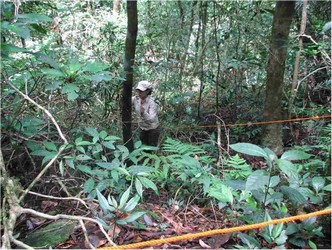Agasthya
A newsletter on the Natural History, Ecology
and Conservation of the Agasthyamalai region, Western Ghats, India.
ASHOKA TRUST FOR RESEARCH IN ECOLOGY AND THE ENVIRONMENT
Centre for Excellence in Conservation Science
Royal Enclave,Srirampura,Jakkur Post
Bangalore-560064
Telephone: 080-23635555 (EPABX)
Fax : 080- 23530070
Any and all opinions expressed in this newsletter are solely those of the author(s) and do not reflect the opinion of ATREE.
Editorial Team
Editor: T. Ganesh
Associate editor: Vivek Ramachandran
Editorial Review: R. Ganesan, M. Soubadra Devy
Design and presentation: Vivek Ramachandran
A S H O K A T R U S T F O R R E S E A R C H I N E C O L O G Y A N D T H E E N V I R O N M E N T
Carbon storage and forests
- Prerna Rajiv Agarwal and Rachakonda Sreekar
Laying plots to estimate 'above ground' carbon.
Photo: R. Sreeker
'Grunt'...the moment we heard it, we froze. We could hear our heartbeat, when came another louder, sharper 'Grunt' from behind the bushes. As soon as we heard it, we fled. We could only suspect the 'grunter' to be a gaur, but on another similar occasion, we actually saw the cause of our desertion of the plot- a wild elephant! We were sampling in a rectangular plot, meticulously measuring the girth and height of each adult tree before the 'grey giant' forced us to abandon our work.
These exciting experiences occurred while sampling to examine and compare the above ground carbon between three habitat types in KMTR- primary, secondary and corridors. Our hypothesis was that primary forest would contain more carbon as compared to secondary and corridor habitats. To lay the sample plots, we walked through the undisturbed, thick canopied trails of the wet evergreen 'primary' forest at Kakachi; disturbed, leech laden 'secondary' forest at old Kakachi and Kodayar; and explored the linear fragments of forests called 'corridors' at Nalmukh, which studded the tea plantations and served as wind barriers. Together as a team, we finally achieved the target of sixty plots!
After data analysis we found that the girth class distribution were significantly different between and secondary and corridor habitats but did not differ significantly among the primary and secondary habitats . As hypothesized by us, the bio-volume and above ground carbon[tons of carbon dioxide equivalent (tCe)] was significantly higher in primary forest (1643.8 ± 1049.9) as compared to secondary (1249.6 ± 1339.0) and corridor habitats (664.1 ± 759.7). Our results indicate that old growth forests are extremely important as carbon sinks "those that store more carbon than they release and are continuously increasing in size". But we believe that in the wake of increasing habitat destruction and carbon emission, the contribution of remnant forest like secondary and corridor cannot be ignored. Another study by Sandeep and Anand also supports our view, which shows that corridor patches harbour rich bird diversity, similar to that of primary forest.
Hence, in the larger context, the services provided by corridors will be invaluable - as carbon sinks, as links for animal and plant movement and as indicators of subtle changes. Since carbon credits are now accepted internationally, these can be used as an incentive to conserve the corridors by the tea estates, to offset their carbon footprints. It is high time we realise the value and provide protection to other forest habitats whose ecosystem services are neglected most of the times!








